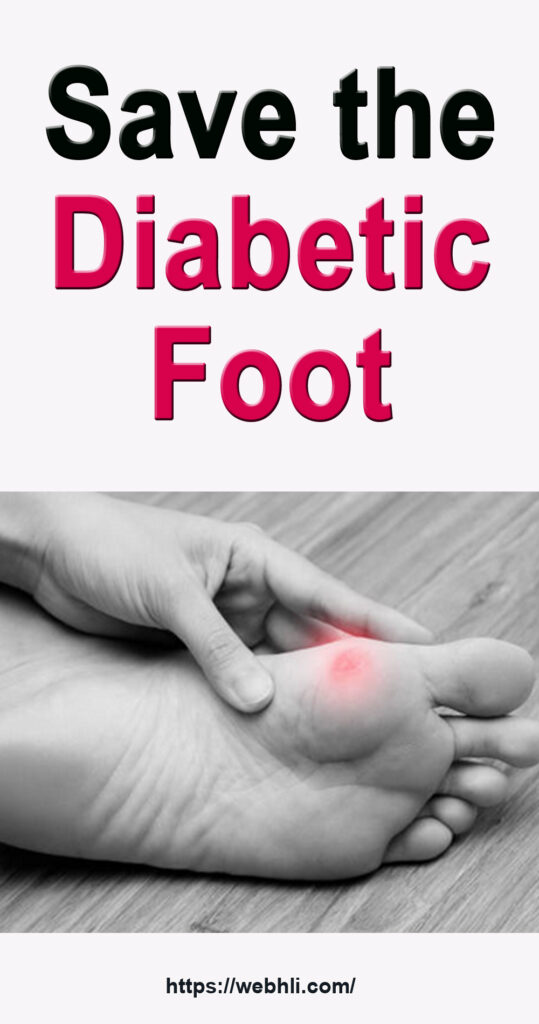
A Diabetic patient becomes very careful about regular Blood Sugar monitoring and the necessary medication but is ignorant about realizing that a minor problem in his foot un- noticed can in due course of time progress to a major traumatic happening in his life.
Burning and Pricking sensation of foot and Pain and discomfort in the foot while walking are early signals of diabetic foot involvement, which the patient some time fails to report to the Physician.
Therefore besides conducting routine investigations of a diabetic patient the condition of the Foot of the patient should not be ignored. The patient has to be pre-warned about the various complications. A diabetic patient becomes prone to Hypertension, Obesity, Cardio Vascular Ailments among them is hidden and unlooked proneness to Foot abcesses, ulcers, gangrene etc. The battle is won if the foot of the patient can be saved by proper and timely guidance by the treating Physician and other doctors.
Check out these related articles, too:
Zinc Shown to Promote Insulin Production In Diabetics
Prevent Side Effects From Diabetes Drugs
Why You Should Stop Taking Drugs for Your Diabetes
What Does It Mean To “Reverse Diabetes?”
Minerals That Lower Blood Glucose
Skin Problems Connected to Diabetes
What is the biggest contributor to diabetes?
Diabetes and Higher Than Normal Fasting Blood Sugar Levels
The dreadful aspect of Diabetes:
One of the most dreaded complications of diabetes is gangrene of foot and leg. Approximately more than 50 % diabetic patients suffer from peripheral neuropathy and 25 % suffer from vasculopathy and 15 % suffer from foot problems (deformity, ulcer gangrene). Therefore more than 1 crore persons with diabetes are likely to suffer from foot and leg problems. It is important to realize that majority of these patients will be of age group 35 to 45 years. Many of them are likely to loose their legs. This can be a serious economic and social problem. Therefore we in India need to find out solution, which is affordable and accessible.
It has been accepted now that only strategy for preventing amputation of leg is to prevent foot ulcers by controlling diabetes, regular check up for Neuropathy and Vasculopathy and advise to wear correct footwear. Once Neuropathy and Vasculopathy is diagnosed a proper and timely treatment prevents the foot ulcer.
Foot ulcers and other foot problems are one of the commonest causes of morbidity, significant disability and even mortality among the diabetics in our country.
Amputations that can be prevented:
About 50000 amputations of lower limbs are done for diabetic gangrene every year in India, thousands go unreported. Society pays for amputation but not for saving limbs. We need to change this. Slow progress in accepting scientific ways to save the foot.
Just as tripod relies on all three legs to stand, the standard care for diabetic ulceration of foot depends upon debriment, antibiotics and pressure relief. Failure to address any of these areas can lead to serious complications or possible amputation.
It is adequately apparent that rural or semi-urban areas also have large enough prevalence of diabetes. It is a public health issue. According to W.H.O. estimate there are 8 crores of people will be suffering from diabetes in India out of which 1 crore patient's feet will be at risk of suffering from leg and foot ulcers. Diabetic foot forms upward of one third admissions in hospitals. The morbidity and low quality of life after amputation is very painful.
Diabetic Foot Society of India leads in it's crusade:
Diabetic foot Society of India (DFSI) has tirelessly worked to train and sensitize thousands of medical professionals who deal with diabetic foot problems as a mission to prevent any amputation. Hand book of Diabetic Foot Care published by (DFSI) in Nov. 2005 was a run away success. The large number of informative booklts were distributed among doctors.
DFSI's Hand Book is adequate for quick understanding issues of Neuropathy and it's assessment how to relate risks of diabetic foot with ulcer, amputation proneness thus detecting foot at risk, peripheral vascular disease conservative foot salvage surgery, the need for higher referral and diabetic footwear. It also emphasizes on the immediate care to contain and care and cure the first contact point on health care. We hope it helps the frontline soldiers of our profession, who often work with limited facilities.
A successful diabetic foot care programme focuses it's efforts on prevention. Two very important aspects of preventive approach are education and the use of proper footwear. Unfortunately, it is not uncommon for a patient to seek a foot care advice only after he or she has already developed a problem such as diabetic ulcer. Often these patients have never been tested for peripheral neuropathy and vasculopathy or have not been tested recently and many are altogether unaware of diabetic peripheral neuropathy and it's associated risks. It can be quite challenging to convince person who has never had foot discomfort to restrict their footwear choice to only those shoes that are considered by health care provider to be appropriate - this task can be completed most efficiently when a diabetic foot care team, whose members support each other and collaborate in the interest of patients.
Diabetic Foot Care is a Team Work:
To prevent the dreaded complications of diabetic foot to progress to a stage requiring amputation, it is necessary that Diabetic Foot Clinic in hospital should have a team of specialists.
A multidisciplinary Diabetic Foot Clinic in the hospital can reduce the number of Amputations and has also developed as a successful model of diabetic care through out the world.
Gateway optimal health is with you on your journey to Disease free Healthy Life Styles.
Author: Jagmohan Singh Chadha
Website: [http://www.gatewayoptimalhealth.com]
The author has 30 years experience in Pharmaceuticals & Nutrition Industry. You shall get a chance to see more information on Optimal Health and Disease topics at this site regularly.
Article Source: http://EzineArticles.com/1608315

 Protected by Patchstack
Protected by Patchstack